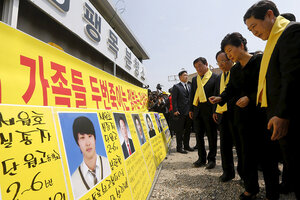As South Korea mourns Sewol victims, president vows to raise ferry
The sinking of the Sewol ferry a year ago was the worst peacetime civil disaster in South Korean history. Families of the missing and dead remain aggrieved over the handling of the rescue operation.

South Korean President Park Geun-hye (2nd r.) looks at portraits of missing passengers who were on board the sunken ferry Sewol during her visit to a port in Jindo, on the occasion of the first anniversary of the ferry disaster that killed more than 300 passengers, April 16, 2015.
Yonhap/REUTERS
Amid public rancor and mistrust in South Korea, President Park Geun-hye promised Thursday to raise a sunken ferry from the ocean floor that capsized a year ago with the loss of 304 lives. Some of the dead, who included nearly an entire high school class of 250, have not been recovered.
President Park made the promise after visiting a memorial site for the nation’s worst peacetime civil tragedy. Relatives of the victims refused to meet with her, leaving an hour before she arrived. A separate commemoration was cancelled by the most prominent family activist group as a form of protest.
The sinking of the Sewol ferry highlighted poor public safety and security measures in Korea, a maritime nation. This includes the illegal practice of removing ballast from ships so that they can carry more cargo, thought to be the main reason the Sewol capsized as it tried to make a sharp turn in high seas off the port of Jindo.
The emotional anger around the sunken ferry has built into a popular cause on the streets of Seoul that has hurt Ms. Park's standing. She presided over a botched ferry rescue attempt a year ago when coast guard helicopters and vessels hovered near the capsized boat but were unable to reach those trapped in a cabin before it sank.
Speaking Thursday at an alternative memorial site at the port in Jindo that was swathed with the yellow ribbons that have become the public symbol of the sinking, Park said she would take "the necessary steps to salvage the ship at the earliest possible date," according to the BBC. The recovery cost is estimated between $100 million and $200 million.
Park urged her country to move past grief and anger. “I earnestly appeal to the people: It’s time to overcome the pains and hardship from the Sewol incident and move on to build a new South Korea. We cannot stay trapped in the sadness and frustrations that have gripped us for the past year,” she said.
Some Korean media have portrayed Park as treating the disaster with the kind of detachment that US President George W. Bush was criticized for in the early days after Hurricane Katrina hit New Orleans.
But the frustration may run deeper still as the Christian Science Monitor reported yesterday:
Demands for deeper answers persist in part because many Koreans say the Sewol disaster reflects a wider malaise in a country that industrialized at breakneck speed. They ask if South Korea has sacrificed safety and clean business practices in the pursuit of financial gains and economic development.
“The Sewol sinking is not considered an isolated incident because it is seen as having been caused by the problems shared by all sectors of the national economy,” says Se-Woong Koo, editor-in-chief of the polemical news site Korea Exposé.
According to Mr. Koo, those problems include a “disregard for public and worker safety, cutting corners for cost reduction, the culture of ‘pali-pali,’ which means ‘faster and faster,’ the entrenched ties between the business community and the bureaucracy, and above all, the obsession with obvious results at the expense of fundamentals.”
According to Reuters, Korean officials were booed Thursday in the town of Ansan, site of Danwon High School whose students were on a class trip from Incheon to Jeju island, a popular resort.
The New York Times reports that many of the students who were trapped below deck as the ferry sank "sent text messages and smartphone video clips from inside the slowly sinking ship, asking for help that never came and bidding farewell to their parents. Crew members fled the ship after telling passengers to stay put. Coast Guard officials did little more than pick up passengers who escaped on their own."

